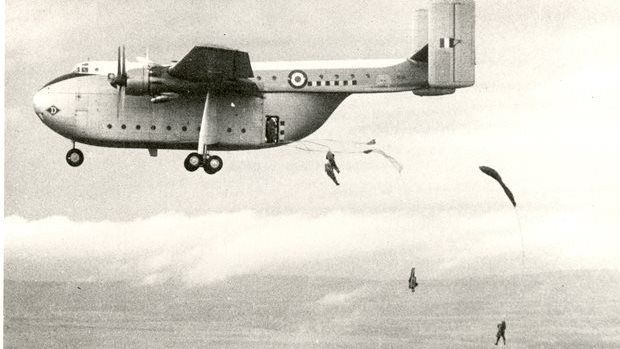Into the Archives – The Beverley

Designed and built by General Aircraft as the GAL.60 Universal Freighter, the first aircraft had its maiden flight on 20th June 1950. This was followed by a second, the GAL.65, which was modified from the original. Clamshell doors replaced a combination of a door and ramp, and the Tailplane boom received seating for 36 passengers. The Bristol Hercules engines became Bristol Centaurus with reverse-pitch propellers, a feature that gave it a short landing length and the ability to reverse under its own power. The take off run at full load was given as 790 yards, the landing run at full load, 310 yards.
The RAF placed an order in 1952 as the Beverley C.1 (Beverley, Cargo Mark 1) and it was confirmed that all of the Beverley’s would be built at Brough Site.
The aircraft was a high-wing cantilever monoplane with a fixed undercarriage. The large fuselage had a tail boom fitted with a tailplane with twin fins. The tail boom allowed access to the rear of the fuselage through removable clamshell doors. A 36 ft (11 m) main fuselage space was supplemented by passenger accommodation in the tail boom. The main cargo hold could accommodate 94 troops, with another 36 in the tail boom. In operation, it was regarded as “ungainly but highly effective” and was described by Air Chief Marshal Sir Robert Freer as “like something out of the Ark, but it was a superb supply dropper.”
The aircraft was designed for carrying large bulk loads and landing them on rough or imperfect runways, or mere dirt strips. It could trace its design back to the GAL49 Hamilcar glider of the Second World War. When it entered service it was the largest aircraft in the Royal Air Force (RAF). It had a large interior cargo area split into two levels which amounted to around 6,003 ft (170 m) of space. Paratroopers in the upper passenger area jumped through a hatch in the base of the boom just in front of the leading edge of the tailplane.
The Beverley was equipped with toilets, which were situated in the tail beyond the paratroop doors located on the floor of the tail boom. One fatality was caused by a serviceman who fell twenty feet to the ground when exiting the toilet, unaware that the paratroop doors had been opened. Modifications were made to prevent the toilet doors from being opened when the paratroop doors were open.
In total, 49 of the aircraft were produced, with the last one being manufactured in 1958, and final retirement from RAF service was in 1967.
Posted by HEP Communications | 12 May 2015
Photo credits: BAE System (Operations) Ltd.
Sources: Flight;Feb 1955 Beverley build up p 148, Air Chief Marshal Sir Robert Freer”. Daily Telegraph. 1 Feb 2012. Retrieved 2 Feb 2012, The Blackburn Beverley Association – Tour Beverley XB259: The Exterior.” The Blackburn Beverley Association. N.p., n.d. Web. 11 July 2010. http://www.beverley-association.org.uk/xb259/exterior.htm




